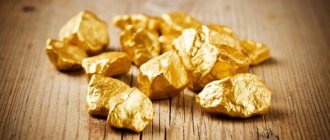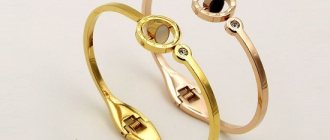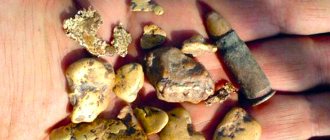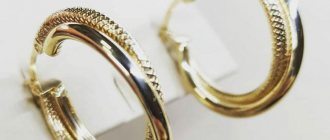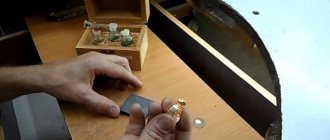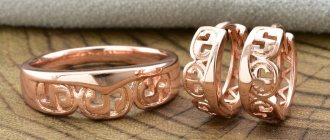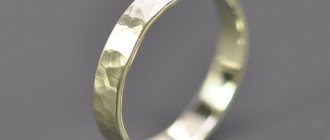Most people are familiar with white and yellow gold, but this is not a complete list of varieties of the precious metal. Among them there are rarer ones, such as a blue alloy. Jewelry made from this material is in demand despite the fact that their price is tens and sometimes hundreds of times higher than the average market price of products in this category. This is explained by the difficulties associated with manufacturing the alloy.
It is still unknown exactly how blue gold was previously obtained.
Several methods have been discovered and are used today. However, to maintain the original properties, it is necessary to ensure proper care of the products.
What is blue gold
Blue and blue gold are metals with similar properties; they are distinguished by the intensity of their shade, which is due to the difference between the compositions. Alloys can be produced in different ways, but not all of the finished materials are characterized by suitable operational parameters. In addition, even the blue color sometimes does not correspond to CIELAB color coordinates, metal is so arbitrary. In fact, the precious metal obtained using one of the technologies is characterized by a grayish tint. When the composition changes, it acquires a bluish tone. These materials belong to the group of intermetallic compounds.
They are alloys obtained by chemical reactions through the interaction of different components.
Gold ring with a blue tint
How is gold different from platinum?
Although they look very similar, platinum and white gold are different metals. They have their own properties and advantages that make them unique.
Platinum is a precious silvery-white metal that does not need to be alloyed to impart color. It is rarer than gold and is stronger and denser than white gold.
Unlike white gold, platinum jewelry is purer: it contains 95-98% platinum and 5-3% silver and rhodium.
Because gold jewelry contains more alloys (which is supposed to provide extra strength and durability), it costs less than platinum jewelry.
Both metals have the same cost per ounce (about $1,900 per ounce), but jewelry requires more platinum because it is denser. Due to its higher melting point, platinum is more difficult to process. These are some reasons why platinum rings cost more than white gold rings.
The other main difference is that 22, 18, or 14 karat gold is harder to scratch than platinum. Additionally, gold jewelry requires less cleaning and polishing. This is not the case with platinum jewelry - the cost of maintaining it is quite high as it needs to be cleaned and polished at regular intervals to maintain its smooth and shiny appearance.
Platinum (left) and white gold ring on the right.
However, both white gold and platinum have the same white color. It is quite difficult to notice the difference with the naked eye.
Quick comparison
| White gold | Platinum |
| With a specific gravity of 19.3, gold is lighter than platinum. | Heavier than gold; specific gravity 21.4 |
| Affordable compared to platinum | 30-50% more expensive than white gold |
| It requires cleaning and polishing every few years to maintain its shiny appearance. | Cleaning and repolishing should be done regularly to maintain color and shine. |
| When scratching, a tiny amount of gold is lost | The platinum is scratched, but this is just movement of the metal parts, and not a single volume of it is lost. |
| Because it contains a mixture of metals, some of these metals, such as nickel, may cause an allergic reaction when worn for long periods of time. | Unlikely to cause allergic reactions |
Composition, shades and hallmarks of blue and light blue gold
Today you can buy jewelry made from a rare alloy, which includes the following components: gold, steel, platinum, iridium. Their ratio is, respectively: 75%, 22%, 2.5% and 0.5%. This version of the heavenly-hued precious metal is the most common today. For comparison, the Argentinean Antoniassi previously used a method based on 90% gold, to which, among other things, a small part of cadmium was added. Nowadays, other intermetallic compounds (alloys obtained chemically based on 2 or more metals) are also used:
- standard 585 and 750, for which pure gold and iron are used in the ratio: 2:1 and 3:1, chromium and other alloys are added to the composition to improve properties;
- indium-based alloy: it allows you to obtain a precious metal of a grayish, bluish and even deep blue hue (depending on the composition), the ratio of components: 46.2% gold, 53.8% indium, as a result the standard is quite low - 462;
- based on gallium - the metal acquires a pale blue tone (component ratio: 56% gold, 44% gallium).
Shade options
The gold alloy of unconventional color has several shades. It can be either light blue or dark, rich blue, like a twilight sky. The variety of colors directly depends on the amount of a third-party component added to the gold.
It is generally accepted that blue and blue gold are one alloy with additional elements. However, this is not quite true. They have different composition. To create a palette of shades, various ligatures are used. Accordingly, the final result will differ. However, combining all the resulting alloys into one subspecies of the color category or dividing them into independent representatives is an entirely subjective choice.
Physical properties of chemical alloys of exotic gold
The main characteristics of the heavenly colored precious metal:
- low strength, which determines the wear resistance of products - they are easily damaged and wear out quickly (traces of use appear);
- low plasticity;
- magnetic properties depend on the steel content; not all technologies for the production of precious metals characterized by a heavenly hue require the use of such a component;
- fragility - metal cannot withstand pinpoint impacts.
Important: Not all types of jewelry are characterized by the same properties, which is due to the difference between the compositions: some deep blue products crumble and deform at the slightest pressure, others are more resistant to mechanical stress (most often those that contain iron behave this way) .
Blue gold is a rare type of material
How to artificially create tarnish colors
In metalworking, bluing is actively used. The technology of special coating of metals with oxide films is well known and actively used for decades. Blued material is resistant to rust, resistant to increased loads and has an aesthetic color, without additional coatings with paints.
To perform bluing you need:
- dip the workpiece, wipe it with mineral oil;
- heat on a metal sheet to a temperature indicator (it varies for different metals and alloys);
- then quench in a cooled area to avoid metal tempering.
The resulting oxidized layer on the structure of the metal product will be resistant to water. It will have increased resistance to external factors.
The following table shows the compositions of solutions and the required temperature for alkali-free oxidation of ferrous metals:
An oxidation film is formed at both high and low rates. Film formation is influenced by factors such as:
- a measure of hardening of the workpiece (hardening helps accelerate the appearance of an unusual effect);
- contamination (when dirt appears, it is charred, and, as a result, an uneven film layer of oxide is formed);
- roughness (the workpiece, which has a recess, receives a compacted film; an aesthetic color difference cannot be detected, and a polished part creates a multi-colored effect);
- heating technology (depending on the special equipment used to heat the parts, oxidation films are formed at high speed and width; to heat the parts, it is better to use equipment that allows you to maintain the required temperature and control it).
Thin oxide films absorb solar waves at the shortest wavelength, but reflect at the longest. When heated, the color of the metal changes depending on the temperature. The higher the temperature of the oxide film, the lighter the color of the metal when heated. Blue and violet colors are produced when a list of long wavelengths is displayed from the spectrum. When a film of oxides of a wave with a minimum wavelength is reflected, the metal surface is painted in a yellowish tint. Light shades correspond to increased heating temperatures. Therefore, the master often determines, using the colors of the tarnish of stainless steel, the hardening of materials with steel shavings and piercing tools. They are used when working as a turner.
Despite these factors, it is impossible to accurately determine the temperature of the metal using the tarnish color of stainless steel, since the indicator is influenced by various factors:
- heating period (the period of time during which the metal part warms up to the temperature of the room, if there is no thermal output);
- various impurities in iridescent metal;
- peculiarity of lighting in the room where welding and hardening of workpieces was carried out;
- warm-up rate (temperature change per unit time during warm-up).
Among various electrical appliances, there are pyrometers that provide specific temperature control. They operate on laser beam analysis. Electrical appliances contain special sensors that analyze the reflected rays and reflect the metal temperature, which is equal to the measured radiation parameters.
Secret modern technologies for producing sky blue gold
There are several technologies for producing blue alloy. They involve connecting components and protecting finished products with a special coating. Different manufacturers use their secrets to obtain blue gold. Moreover, the exact formula is hidden. Despite the international rule established by the association of jewelers, not everyone discloses the production technology, not to mention the composition of the material.
Chemical alloys
In the production of blue precious metal jewelry, different technologies are used: alloy with iron, chemical reactions with other metals. Intermetallic compounds are compounds of gold and gallium or indium. The last of the components are fusible, they improve the properties of the material. The result is blue gold with improved characteristics than pure metal.
Such production technologies have the advantage that the product acquires the desired shade throughout its entire thickness.
Production of alloys from pure metals
Rhodium plating
In order for the decoration to obtain a noble color, a heavenly shade, different coating methods are used:
- applying special varnish;
- use of rhodium.
The presence of a coating improves the properties of the product, while the heavenly-hued precious metal retains its attractiveness longer. However, the surface layer itself is not strong and is deformed.
This means that jewelry made using this technology is less durable and has less value.
What determines the color of the metal?
The emergence of colored varieties of gold is due to the impossibility of using this metal in its pure form to create jewelry. As you know, pure gold is soft, as a result of which this material can only be used in jewelry in the form of an alloy.
It was the addition of various chemical elements to the composition in order to strengthen the metal that had a key impact not only on the physical properties of the material, but also on its color. Combining gold with additional “strengtheners,” jewelers were surprised to discover that the impurities seemed to tint the metal, and the resulting substance was no longer yellow.
This unexpected discovery gave the world many different color variations of gold and actually gave jewelry makers complete freedom of creativity - now they could create gold items of almost any shade. To simultaneously strengthen and paint in various colors, the noble metal is still combined with the following elements:
- aluminum,
- nickel,
- palladium,
- rubidium,
- chrome and others.
Today, the jewelry market offers gold products in a variety of colors. In addition to blue and cyan, unusual (that is, non-standard) shades that are in great demand include:
- white,
- green,
- red,
- violet,
- black.
The creation of blue and cyan gold is the most secret process. The technology and nuances of obtaining metal of these particular shades are carefully hidden by manufacturers and are therefore only partially known.
Narrow use of blue gold in the jewelry industry
Considering that sky-colored metal is not durable, is susceptible to pinpoint impacts, is not plastic and does not have a tendency to stretch, its scope of application is narrow. This material is used primarily for the manufacture of decorative inserts for jewelry; less often it is used in the production of solid objects. Inserts made of bluish-toned precious metal can be found in certain types of products:
- cases, bracelets of watches;
- typesetting items.
How to remove tarnish from stainless steel
Stainless steel changes color depending on the thickness of the oxide film. By heating you can obtain a large number of different color shades. Often, azure, lilac, emerald, and gold colors appear on stainless steel. There are different ways to remove tarnish from stainless steel.
Chemical method
You can remove the unaesthetic color of stainless steel using any acid. At home, vinegar should be used to remove tarnish. To get rid of tarnish, you need to heat the stainless steel and pour vinegar. Then you will need to wipe the surface for a short time.
You can remove tarnish on stainless steel using any acid-based solution. Concentrated nitric acid is suitable, it will clean the metal and passivate it.
Our company uses the following technology for chemical removal of tarnish on stainless steel. The following products are consistently used:
- We start with degreasing
. We use a degreaser for all types of metal SteelGuard MultiClean - We continue with the etching procedure
. The following can be used: SteelGuard InoxClean Spray Etching Gel/Spray or SteelGuard InoxClean Dip Etching Agent - And we end with passivation
. Used: Passivator for stainless steel SteelGuard InoxPass Spray or Means for restoring the passive layer of stainless steel SteelGuard InoxPass
Mechanical method
It is possible to remove tint transitions with other visual defects using a felt wheel for an angle grinder and GOI pastes. A felt circle can be made from old felt boots - to clean it you will need to apply GOI paste to the felt circle and polish the metal. Instead of felt, you can use a Scotch Brite pad or polished muslin pad to remove tarnish on stainless steel. When using an angle grinder, you should connect a speed controller.
How to choose the original
Not every piece of blue jewelry contains gold. To check whether a ring or chain is a piece of jewelry, the following criteria must be taken into account:
- hallmark and manufacturer's mark: a product that contains a precious metal is always marked with a symbol that determines the value of the alloy used in production (fine), most often there is also a manufacturer's mark;
- magnetic properties: for comparison, yellow gold does not exhibit such characteristics, however, the blue alloy may contain iron, which puts the jewelry into a lower quality category, and products of this type also exhibit magnetic properties; there are also varieties of blue precious metal based on gallium and indium , they do not contain steel;
- trusted brand, well-known salon: large stores have gained popularity due to the sale of certified high-quality goods; when purchasing, you should choose well-known retail chains that have been on the market for a long time;
- an electronic detector is one of the expensive methods; such a device is not available everywhere, but thanks to the detector you can determine the electrical conductivity of the metal, which will allow you to find out its composition;
- shopping accompanied by a jeweler: you need to invite a trusted specialist, but his services are an additional expense item; as a result, the jewelry will cost more in total.
Jewelry made of gold with a blue tint with green stones
Important! You should not check jewelry using traditional methods (using vinegar, iodine, etc.), because they do not guarantee an accurate result, they can ruin the product, in addition, often improvised means give a false impression of the properties of the jewelry (when applied, the material does not lose its properties, like gold, but there is no precious metal in the composition).
General information
The appearance of blue gold products dates back thousands of years. The first craftsmen to learn how to produce metal were the Scythians. Some jewelry created by craftsmen from a traditional alloy with a sky-colored finish can still be found today.
Due to the high historical value, no one dares to conduct chemical experiments with ancient exhibits. Therefore, the secret of creating blue metal is shrouded in mystery and so far no one has figured out the full list of its components. However, there is information about the process of creating the blue alloy, which was practiced by ancient alchemists. According to them, to obtain an unusual material, you just need to combine iron and gold in a ratio of 1:3. For example, 25% of ordinary raw materials and 75% of pure precious metal are taken.
A similar method was used back in the 17th century, and three centuries later, the famous jeweler Antoniassi from Argentina discovered a way to produce an alloy containing 90% pure gold. The heavenly shade was achieved by adding cobalt in very small quantities. After a successful experiment, the jeweler was forced to disclose the entire list of components used, but he hid the technology for connecting them to each other. Jewelers still cannot obtain blue gold according to Antoniassi’s recipe.
Blue gold – an alloy of 18-carat precious metal and iron
What does blue gold represent for modern masters? This is an alloy of 750 precious metal and iron. Despite the presence of noble raw materials in it, it has more steel qualities than gold ones. If products made from such material are not properly cared for, they will irrevocably lose their aesthetic properties.
The main use of blue gold is jewelry. It makes unique jewelry such as rings, pendants, earrings, etc. Metal of unusual color can also be found in wristwatches. Most often it is used to create a body, followed by varnishing. Varnishing with a special composition helps protect the surface from mechanical damage and makes caring for products less troublesome.
How to care for fragile metal
Basic recommendations:
- blue gold is easily damaged, so jewelry of this type should not be worn daily;
- Products should be wiped from time to time with a rag soaked in a soapy solution;
- For storage, choose a box with a soft coating inside, but it is important to keep jewelry made of blue precious metal separately from the rest.
Gold ring with blue tint
Properties and Features
The process of synthesizing metals to produce a precious alloy of unusual color is quite labor-intensive. Parts made from blue raw materials are attached to the main surface by soldering. A distinctive feature of the alloy is its fragility, which is also reflected in jewelry made from it. That is why they must be treated very carefully.
What does blue gold look like?
Alloys with the addition of third-party components, which give gold a sky blue or blue color, are not ductile; the material cannot be drawn into threads and forged, giving it the desired shape. This significantly limits its use and makes it impossible to create elaborately shaped products with many decorative elements.
Jewelers prefer to use the blue shade of gold as interesting inserts and elements in products. For example, earrings with a yellow gold frame and a colored center look beautiful.
Where can you buy and how to sell blue jewelry. Cost of 1 gram of blue gold
You can't buy heavenly shades everywhere. The likelihood of finding them in the assortment of large retail chains is much higher than in small stores. It is difficult to sell such products because their cost is high. Options to consider:
- pawnshop;
- selling to a store for the purpose of purchasing a new product.
The cost of jewelry of different composition differs significantly. If we consider blue gold, the price for 1 gram today is 10,000 rubles.
Reviews
My husband gave me a bracelet with blue gold inserts. To be honest, for a long time I thought it was colored blue metal (no one showed me the receipt, naturally). I recently found out that the price of this blue gold per gram of 585 samples was amazing - more than 9,000 rubles. After that, I looked at my husband differently; it turned out that, although he is silent, he appreciates me.
Nastya Grineva, Beloretsk
Angela Gusina, Krasnodar
When I worked for a foreign company, I could afford a holiday in the Maldives 4 times a year, expensive jewelry. There was even a blue gold ring. But when worn it is so-so, it gets scratched quickly. I only wore it to special occasions.
One day, an unpleasant situation happened with blue gold: an ex-boyfriend gave it as a gift and presented it with pathos. Later, when we had already separated, I decided to sell it; it turned out that it was a simple decoration coated in a blue tone. The price, of course, is different for such a product - much lower.
Veronica S., Nizhny Novgorod
The Birth of Blue Metal
The eighteenth century was ending. The peals of the French Revolution thundered. Popular uprisings engulfed the European continent with bright flames.
The Industrial Revolution was ending in England. James Watt's steam engine marched victoriously around the world, conquering mines and factories. The mighty power of steam turned the flywheel of world culture. The time had come for the discovery of new metals.
Back in the Middle Ages, alchemists expressed the idea that there was some kind of metal in clay. Perhaps this was the “philosopher’s stone” - the substance with which gold can be artificially obtained? But the forces of alchemy were weak to disrupt the fatal friendship between aluminum and oxygen that arose millions of years ago.
The era of magical alchemy has sunk into eternity, science slowly, step by step, laid the foundations of a materialistic worldview. The mighty power of electricity opened up new, vast horizons for the metal hunter. The first chapter of the glorious history of the struggle for aluminum had begun.
The Englishman Humphry Davy was the first to embark on the path of discovering new elements. He discovered a remarkable family of alkali metals - potassium and sodium. Aluminum was next in line.
Humphrey, the son of woodcarver Robert Devey, was born in the rainy and foggy winter of 1778. From a very early age, the boy surprised everyone with his development and extraordinary talent. Before he was six years old, he already knew how to read and write. But his father died unexpectedly, and his mother with five small children found herself in a difficult financial situation: Robert Devi left his family very little money.
Humphrey's mother sent her son to school with an illiterate teacher, Mr. Gariton. Humphrey spent nine years at school, where Greek and Latin were held in special esteem. Often at school, in the evening, under the monotonous sound of endless rain, Humphrey cried. He cried because of too frequent meetings with Mr. Gariton's flexible ruler, because of the Greek and Latin languages he hated, because of homesickness. Many years later Humphrey wrote to his mother: “I think that I owe my little talents and their special use to my long idleness at Mr. Gariton’s school.”
But time passed, days turned into months, months into years. Devi graduated from school. He took very little out of it. Devi’s three passions only developed even more: the first was to write poetry and aphorisms, the second was to read books on chemistry, and the third was to fish and wander around the outskirts of Penzance.
Having laid out his fishing rods, Humphrey dreamed about the future and, as always, wrote down his dreams and thoughts in a notebook. He wrote: “May each year make me better, more useful, less selfish and more devoted to the cause of humanity and the cause of science.” But the float dived convulsively under the water, and Humphrey, with a cheerful laugh, pulled out the next victim of his fishing art.
Humphrey's mother, the adopted daughter of local doctor John Tonkin, on his advice, decided to develop her son's second inclination as the most useful: he should study chemistry. And then one day his mother suggested that Humphrey wear a festive dress. This happened on February 10, 1795. It was an everyday day, and, naturally, Humphrey was surprised by his mother’s unusual proposal. But after half an hour everything became clear: a contract was signed at Borlaz’s pharmacy. Dreams of university collapsed like a house of cards. To study his favorite chemistry, one had to be content with the modest role of a pharmacy student.
Six years passed, and an amazing metamorphosis took place. The pharmacy student turned into a young talented scientist. Devi was invited to Bristol to study the effects of gases on the human body. There he attracted everyone's attention, having completed a number of spectacular, although not of great scientific significance, work. Count Rumford had recently founded the Royal Institution in London, and the popular Devy was invited there as a lecturer.
This dizzying career was unique in the scientific world. It is not for nothing that Humphrey Devi wrote in his diary: “I cannot refer to wealth, power, or noble origin for my characterization, and yet if I survive, I hope to be no less useful for humanity and my friends than if I were endowed with all these advantages.”
His contemporaries had the highest opinion of him. “His youth, simplicity, his natural eloquence,” wrote one of them, “his deep knowledge of science, successful examples and illustrations and well-done experiments aroused everyone’s attention and boundless delight. Compliments, invitations and gifts rained down on him from all sides; everyone sought his company and was proud to know him.”
Despite his brilliant success, Humphrey did not succumb to the lure of the social life of huge London. He wrote: “I lead a real and living existence only among the subjects of my scientific work. I need ordinary entertainment and pleasure only as breaks in the flow of my thoughts.”
Several more years passed. The newly invented voltaic pole fell into Devi's hands. And the brilliant young man began a series of persistent experiments to study its chemical action.
Let's take a look at Devi's laboratory, where he worked during these years.
In the middle of the large room there is a long table. Wardrobes with wide shelves line the walls up to the ceiling. Glass vessels of all sizes, filled with liquids and powders of all colors of the rainbow, are placed in the most chaotic disorder on the table and on the shelves. A variety of instruments of the most bizarre shapes clutter this room, which looks more like the attic of a junk dealer than the laboratory of a great master of science.
The Voltaic pillar, erected on a special pedestal, rises among the apparent disorder, so familiar and necessary for the passionate nature of the young scientist. Devi researches alkalis. He is confident that potash and soda cannot be elements; the entire force of the Voltaic column must be directed to split these substances.
One October day in 1807, Devi, as usual, arrived at his laboratory at ten o’clock.
He took a platinum cup from the cabinet and poured some potash into it from the bag. While the potash was melting on the fire, Devi was setting up the battery. Something was boiling in a cup, and the clock's pendulum was rhythmically knocking. Devi rushed from one corner of the laboratory to another. A glass jar rattled and shards of glass scattered across the floor.
The yellow London fog turned day into night; The gas jets of the street lamps gleamed dimly outside the window.
Finally, a platinum cup containing molten potash was connected to the positive pole of the post, and a platinum wire connected to the negative pole was immersed in the molten substance. The circuit was closed. An electric current passed through the potash and began its wonderful work.
When Devi saw tiny grains of the new metal, potassium, lighting up in the air, he jumped around the room like a child, unable to contain his joy.
After potassium, sodium was discovered. Devi discovered alkali metals and laid the foundation for a new science - electrochemistry.
The discovery of the metals sodium and potassium, isolated by electric current from alkalis, made a huge impression on the scientific world. Devi was in a halo of glory. In 1808, he wrote: “If I were lucky enough to obtain the metallic substance I am looking for, I would suggest a name for it - aluminum.” For the first time in history, a scientific task was set: obtaining an as yet undiscovered metal - aluminum - from alumina. Devi was confident of his victory and gave the name to the metal in advance.
But the mental tension and creative enthusiasm of a number of years, which led to the brilliant discovery of sodium and potassium, made themselves felt. Devi is overtired. His nerves began to behave extremely strangely: he was feverish, he was excited to the extreme from the most empty reasons. He was haunted by a persistent desire to decompose alumina. In the mind of one man, a force accumulated over thousands of years was at work, demanding to reveal the secret of aluminum, the secret of the most common metal on earth.
Devi was clearly “out of his element.” The extreme negligence that was generally characteristic of him manifested itself especially clearly during these hectic months. Correcting errors in notes, he stuck his finger into the inkwell and covered up the erroneous phrase. He did several experiments at once, moving from one to another without any order. Beautiful silky brown hair stuck to his sweaty forehead, his eyes glittered feverishly, betraying Humphrey's unnatural excitement. The sick Devi was in a hurry to work. He was afraid that he would die without finishing the work, and he increased his creative activity tenfold.
One day he flew into the laboratory like a meteor. The cape flew onto the chair. The experiments had to be completed at all costs!
Hot potassium vapor surrounded the white alumina powder mixed with iron filings, and the mixture melted. Some time after the end of the reaction, Devi removed a white ingot from the crucible, harder and lighter than iron. Chemical analysis showed that the ingot consisted of a mixture of iron and an unknown metal. It already seemed that the job was done.
This was a big step forward, but Devi still did not get pure aluminum. His vitality was quickly running out. On November 23, after a remarkable lecture at the Royal Institution, Devi fell seriously ill. He spent many months in bed; doctors could not determine the nature of the disease. The medicine of that time was unable to provide the necessary assistance to the great man.
London was buzzing like a disturbed hive of bees. During Devi's illness, crowds of London citizens gathered at the offices of The Times and other newspapers: daily bulletins about the health of their beloved scientist were alarming. The best doctors in London refused to take money for visits to the sick Humphrey. Everyone loved Devi, they loved him for his advanced social ideas and bold materialism, they loved him for the charm of his beautiful poetic personality, for his fame as a world scientist.
The illness increased Devi's fame, and as he began to recover, a successful subscription was carried out throughout London for the construction of powerful voltaic batteries.
Two years passed, and the slightly stronger Devi resumed the siege of the fortress - alumina. A different plan of military action was chosen this time.
There was a new large voltaic pole in the laboratory. One night, Devi connected the two poles of a battery and the blinding light deprived him of his vision for a few seconds. For the second time in history, Devi received a voltaic arc. The first in St. Petersburg, six years earlier, was observed by Professor Petrov.
Preparing for the decisive experience, Devi talked to himself:
-Where is this iron wire? After all, I just saw it on the table.
A few minutes later the wire was found glowing in the gas flame. A pinch of alumina has already been prepared on a platinum plate. Devi carefully introduced pieces of red-hot iron and platinum wire into the alumina powder. The battery poles touched the ends of the wire, and a sparkling voltaic arc signaled to the scientist that an electric current had rushed to assault the alumina. In the fire of a voltaic arc, both aluminum oxide and iron wire melted.
The lump of an unknown substance took an infinite amount of time to cool down. Devi was getting impatient, but testing the alloy gave almost the same results as the first time. Devi received an alloy of iron and aluminum. Pure aluminum was not obtained this time either. Devi, who discovered potassium, sodium, barium, strontium, and studied calcium, magnesium, chlorine and wonderful boron, did not discover aluminum. The nut was too hard. He was so hard that even the famous voltaic pillar, which performed miracles in Devi’s hands, could not do anything in this case.
Only three quarters of a century later, scientists of another era, using a dynamo rather than a voltaic column, more successfully harnessed the powerful energy of electricity. But nevertheless, Devi, who rightly received the name of the father of electrochemistry, did an enormous amount in the struggle for light metals. The first enthusiast who lifted the edge of the dark veil covering the mystery of aluminum gave the first impetus. Devi's thoughts and ideas were picked up by other scientists. The hour of solving one of nature's most difficult problems was approaching.
The majestic edifice of modern science did not rise overnight. Over the centuries, humanity has accumulated experience that has made it possible to build scientific theories. Devi's ingenious works were used by a number of his learned fellow contemporaries. Only the combined efforts of scientists around the world could reveal the mystery of aluminum. It was impossible for a single person to solve such a problem.
The general development of science brought the denouement closer.
In 1800, the year the new century was born, Friedrich Wöhler . The quiet and impressionable boy did not show any desire to play in the noisy “Napoleonic campaigns” that so captivated his warlike peers. At an early age, Friedrich showed an inclination towards natural science. And in 1812, when the Wehler family moved to the capital of the world, noisy and diverse Paris, Friedrich had already chosen his future profession.
Years passed. High school student Friedrich Wöhler firmly decided to devote himself to medicine, designed to help suffering humanity. Death decimated tens of thousands of people, epidemics devastated cities. Cholera, plague and smallpox continued to visit cities and villages. Poverty and misery helped diseases. And the young man’s cherished dream was to help people in their suffering.
In 1820, Wöhler carried out his decision. He entered the medical faculty of the University of Marburg. A year later, while continuing his medical studies, Wöhler moved to Heidelberg.
Happy time of youth! The ancient city of science and wisdom, Heidelberg, with its famous university, became the second home of Frederick. Here he found a second father in the person of the famous chemist Gmelin. Modest, shy and at the same time talented Friedrich acquired a real senior comrade and teacher.
In 1823, Wöhler completed his medical education. He was preparing to become a practicing doctor. But Gmelin was able to see enormous talent in the imperfect chemical works of his young friend. And when the decisive hour came, Gmelin used all the power of his influence and persuasion to persuade Wöhler to choose chemistry as the main work of his life.
Seven days of painful hesitation have already passed. Gmelin asked, demanded and begged that Friedrich take the path of scientific activity.
“A chemist, more than anyone else, can, if desired, provide invaluable services to humanity. Medicine without chemistry will never be able to transform itself from an imperfect art into a scientific branch of knowledge.”
The evening twilight colored the mountains with soft undertones. Wehler sat on a stone in the forest and thought, endlessly thought about the future.
He began to remember all the cases when his teachers could not help dozens of sick people. In the faculty clinics there were people dying from consumption, there were young people dying from madness. A long gallery of grief and sadness flashed through Wehler's tired brain.
“Why didn’t the doctors help them? Why didn't they ease their suffering? They knew a thousand times more than me, and yet... Replenish the army of doctors and suffer thousands of times from their powerlessness?.. No! Chemistry, physics - all sciences should help medicine. However, not only science is needed here, it is necessary to change the very conditions of human life. Only through the common efforts of all sciences and all humanity can the cause of therapeutic medicine be helped!”
The perspicacious Gmelin knew that Wöhler would find himself in chemistry. At that time, scientists from all European countries were attracted to Stockholm by the name of Berzelius, the famous Swedish chemist, and Gmelin decided to send Wöhler to his friend in Scandinavia.
On July 17, Wöhler wrote a letter to Berzelius asking for permission to work in his laboratory. A few days later, Wehler received an answer: “Whoever worked for Gmelin will not find anything new from me.” The letter ended with a kind permission to come.
In the autumn of 1823, Wöhler came to Berzelius, and there his choice of a career as a chemist was finally confirmed. In winter, in the laboratory of the great Swede, Wöhler delved deeply into the secrets of research work.
Berzelius admired the young German's successes. He often reminded Wehler of the words from his letter:
“Gmelin’s student will not find anything new in my laboratory.” And perhaps I can learn something from you!
Wehler became crimson and embarrassed. The embarrassment was so strong that only a schoolboy wit from someone present could restore Friedrich Wöhler’s mental balance.
In the spring, Wöhler set off to wander around Sweden. As a result of this journey, he compiled the mineral geography of this country. What kind of stones did this passionate nature lover collect for his collections!
Wöhler's versatile mind and his brilliant work in a world-famous laboratory attracted the attention of wide scientific circles. Berzelius and his students parted with Wöhler with sincere regret. The hospitable Stockholmers will forever remember the high forehead, irregular and sweet facial features of the scientist, whose name in the history of chemistry in the future constituted an era.
A thin strip of land on the horizon is all that remains from Sweden, from Stockholm, from the wonderful school of Berzelius. Wehler was standing on the deck of a small sailing ship bound for Copenhagen. On the way home, Friedrich Wöhler decided to stop by Oerstedt in Copenhagen. From Berzelius he learned about work with
aluminum chloride of this Danish scientist. The name of Oerstedt, his new method of converting oxide compounds into chloride compounds - all this aroused the curiosity of the young scientist and attracted him to Denmark. Wöhler went to Oerstedt to study. He would have traveled all over the world if there had been the opportunity and means to learn more about how and what the scientists of his time were working on.
Back in 1825, Oerstedt, using the experience of Berzelius's work, tried to isolate aluminum from alumina. By calcining alumina together with coal and displacing oxygen with chlorine, he obtained aluminum chloride for the first time in the history of chemistry. The first part of the task was completed. But how now to obtain a metallic substance? Although aluminum chloride did not in any way resemble snow-white alumina, it was certainly not like the sparkling blue metal hidden within it.
An attempt to displace aluminum using potassium amalgam was unsuccessful. Oerstedt did not receive pure metal.
In Oerstedt's laboratory, Wehler learned that he was no longer looking for metal from clay and was not going to look for it in the near future.
Before leaving for Germany, Wöhler spoke with Oerstedt for the last time.
- Sorry, but I still don’t understand what reasons could force you, professor, to suspend work on obtaining aluminum.
- My young colleague! Electromagnetism and the work of disseminating scientific knowledge in the people's universities take up too much of my time. And my very limited strength does not allow me to continue this extremely important and interesting research.
- But you have done so much to illuminate the great problem, because only you could give it complete completion!
Oerstedt rose from his chair and approached Wehler.
- No, my friend, I turned into a magnetic needle, and my strength is not enough to escape from the field where magnetic forces are so powerful. I would be happy if, after our farewell conversation, you, a young and energetic man, would continue my so imperfect works. Do you agree to accept my wishes for complete success in working with metal, the future of which is so difficult to predict? Are you having trouble giving me an answer? However, Jacob wrote to me about your amazing modesty. So-so. A smile appeared! So, do you agree?
- Yes, I will try to confirm your conclusions, professor. I thank you for your generous offer to work on a problem that you have so successfully begun to resolve. I promise to sing-
mother and put this elusive metal on the steel leash of science.
Upon arriving home, Wöhler, with his characteristic enthusiasm, undertook to check the results of Oerstedt’s research. In 1827 he wrote:
“I repeated Oerstedt’s experiment, but did not get definite results. After the distillation of potassium amalgam, which had been preheated with aluminum chloride, the remaining gray molten metal, as the heating temperature increased, began to evaporate in green vapors and was distilled in the form of pure potassium. Therefore, I began to look for another method, without claiming, however, that it was impossible to obtain aluminum using Oerstedt’s method.”
Once again, elusive nature played a cruel joke on two scientists. And, excited by the failure, Wöhler wrote sad lines to his friend Berzelius: “What Oerstedt considered aluminum was, of course, only potassium containing aluminum.”
Convinced that Oerstedt's path would not lead to the discovery of aluminum, Wöhler used pure potassium instead of potassium amalgam. Wöhler tried to treat aluminum chloride with potassium metal, despite the difficulty of working with this metal.
And finally, on October 22, 1827, in Wöhler’s laboratory, gray aluminum powder appeared for the first time in the world - only 30 grams of metal. The dreamy and quiet Wehler revealed the secret of aluminum. Without making any noise, he broke the fatal bond between aluminum and oxygen for the first time. What Devi and Oerstedt could not do, Wöhler did, using new facts discovered by his predecessors, avoiding their mistakes and supplementing his experiments with living scientific and creative thought.
There were still many difficulties to be overcome, much was unknown. Only after twenty years of work on aluminum did Wöhler have the opportunity to write to his close friend, the famous chemist Liebig: “I have found a way to obtain aluminum in the form of grains the size of a pinhead! This metal is very flexible, zinc-white, easily soluble in alkalis and especially in hydrochloric acid.”
The already elderly Wehler retained his outward youthfulness, but it was as if the white alumina had lightly powdered the scientist’s gray temples. It took twenty years of persistent and intense work to obtain grains of aluminum the size of a pinhead! It was necessary to have Wehler's calm determination and endurance in order to devote so much time and effort to the search for aluminum.
In 1835, Wehler traveled to England.
A lot has changed here over the years. Humphry Davy died in 1829. In London, Faraday, a student of Dewi's, continued to work in the field of electrochemistry. He brilliantly used Oerstedt's observations and discovered the phenomenon of induction.
Wöhler paid his first visit to his brilliant contemporary in London.
Faraday was in the laboratory at that time, in the same laboratory where Devi had worked before him.
Wöhler, without warning, along with another German scientist, Magnus, appeared before Faraday, who was confused by surprise. Magnus greeted Faraday, and he, smiling welcomingly, approached Wehler.
— I am happy to host the son of the famous chemist. How is your father's health?
Wehler and Magnus looked at each other in amazement. Faraday was clearly mistaken and mistook Wöhler for his non-existent son.
“I’m very happy to shake Faraday’s hand.” My health leaves nothing to be desired. However, you yourself just perfectly defined his excellent condition,” Wehler said, smiling.
After the discovery of aluminum, Wöhler did a lot more. For the first time in the world, he artificially obtained a substance unique to the animal world - urea. This discovery produced the impression of a bomb exploding among the idealist camp and destroyed the line between the so-called “living” and “dead” nature. The life force theory has suffered a fatal defeat. It turned out that processes taking place in the chemist’s flask are essentially no different from the chemical activity of a living being. With this discovery, Wöhler provided science with another invaluable service. He gave the materialists a formidable weapon against obscurantism and the church, and the natural sciences, in particular medicine, a completely new point of view on the sick and healthy body.
Wehler was not mistaken in choosing his life path: the chemist gave more to medicine than many hundreds of doctors.
The whole world owes to Wehler the first information about this wonderful metal.
Wöhler found that aluminum is only 2.7 times heavier than water. Of all the metals known at that time, it was the lightest metal on earth!
Wöhler discovered aluminum, but the matter did not move beyond “pinheads”. It was not until 1854 that two prominent scientists, Robert-Wilhelm Bunsen in Germany and Henri Saint-Clair Deville in France, successfully repeated Humphry Davy's attempt to produce aluminum using electric current.
Bunsen was born in 1811 into the family of a literature professor at the University of Göttingen. He received his education at the university of his native city. At the age of twenty-two, Bunsen defended his dissertation in chemistry and already in 1836 he took the chair of chemistry at the Kassel Polytechnic Institute, after Wöhler left this position.
Sixteen years later, Bunsen took the chair of chemistry at the University of Heidelberg. In 1854, he decided to continue the research of Friedrich Wöhler, a graduate of the University of Heidelberg, in the field of aluminum.
Bunsen took a new path. He melted a mixture of aluminum chloride and sodium chloride. Sodium chloride - ordinary table salt - was melted together with aluminum chloride, and an electric current was passed through the hot mixture.
The result was immediate. Aluminum precipitated on the negative electrode in the form of shiny droplets. Bunsen proved the possibility of producing aluminum using electricity.
After working with aluminum, Bunsen decided that aluminum was probably not only found on earth.
“Oh, I will discover his presence on the sun, on the planets, on the stars!”
The seeds of a daring thought grew six years later into the discovery of the spectroscope, into a new branch of physics - spectroscopy. Bunsen, together with Kirchhoff, discovered the spectra of almost all elements of the earth's crust. For the first time, a number of rare elements were discovered, present in infinitesimal quantities in the composition of other bodies.
The spectroscope accomplished the impossible - the chemical composition of stars was discovered and their temperature was measured. Aluminum has been found throughout the universe.
Thus ended the first period of the history of aluminum. From the laboratories and offices of scientists, blue metal was supposed to migrate to the workshops of factories.
If you find an error, please select a piece of text and press Ctrl+Enter.
